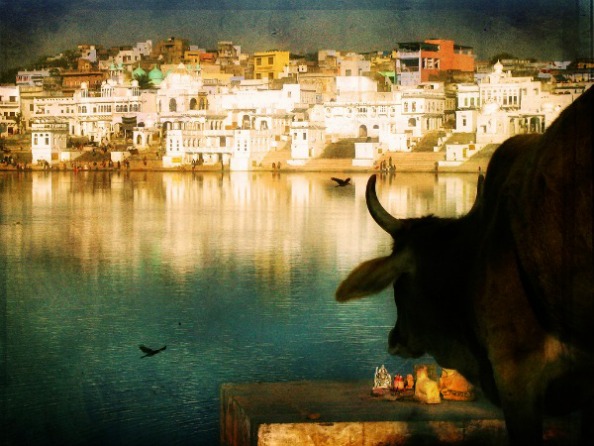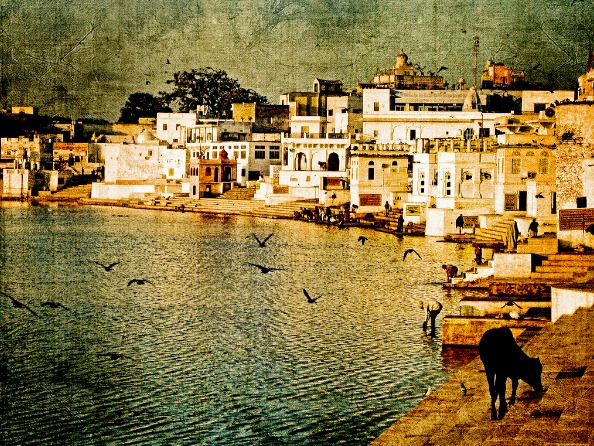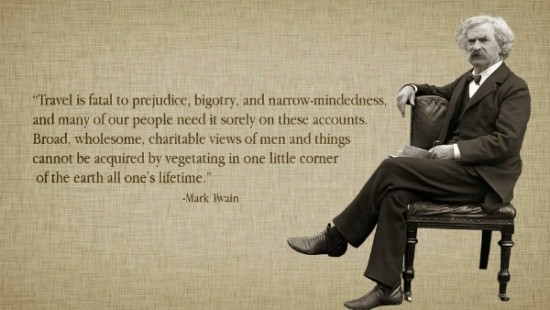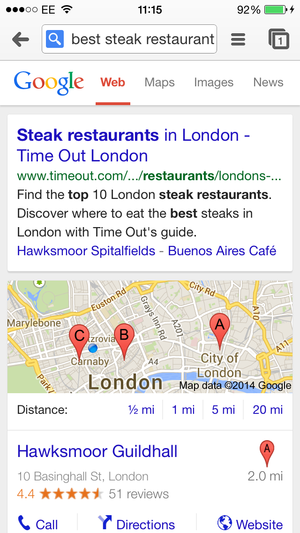
Photo of Pushkar by Nick Kenrick.
How to write about your travels in foreign lands without putting your foot in it
I STARTED TRAVEL writing when I travelled in India for six months in 2005 / 2006. I fell in love with the country, the culture and the people, and wrote from my heart. I never attempted to be objective, but to be honest about what I felt and saw, within the bounds of a respectful attitude. Over the years, as I’ve travelled more, honed my skills and brought more conscious thought to my work, I’ve come to realize that travel writing is a tricky business.
I’ve grappled with how to write respectfully, express my truth, tell a good story and stay true to my values — without offending locals. What I’ve learned is that it takes conscious effort and technical know-how to write effective travelogues. In this post, I asked some of the pros to share their tips and their wisdom for avoiding the cringe-worthy cliches and stereotypes that often subconsciously invade travel writing.
Sometimes you have to challenge your beliefs to get beyond the stereotypes
In Travel is an experience in perception, I tried to grasp this idea that we see the world through our own window, our own set of assumptions, ideas about reality, biases, etc. There’s nothing wrong with this — it’s just about recognizing that your truth is YOUR truth and may not be THE truth.
My photography teacher Tony Makepeace, who regularly visits Nepal and takes portraits of the people he meets there, said, “It’s worthwhile to think about your intentions, reflect on your role as an outsider, and recognize the difference in privilege and empowerment between you and your subjects.”
These first five tips are about how to dig in while travelling and challenge yourself while writing.
Tip 1. Blend in.
“Merge with the place,” Anuradha Goyal recommends. “It helps on two levels. One, with regards to safety and security issues, it helps protect you as you do not stand out. Two, it helps local people feel comfortable with you, and they open up more easily when they see you are making an effort to be one with them.” Anuradha Goyal is a travel blogger & writer, the author of The Mouse Charmers – Digital Pioneers of India (published by Random House) and a voracious reader. She writes a series of Travel Stories on her blog that she says, “would not have happened if I had not connected well by not standing out.”
I completely agree with Anuradha on this one. From my first days in India, I tried my best to adopt the dress and the social etiquette of the culture. When in Rajasthan, do as the Rajasthanis do, was my motto. I found it helped win me respect and trust, and opened up the culture to me.
Tip 2. Talk to locals.
Dan Noll and Audrey Scott of Uncornered Market have been travelling the world for many years, and sharing their stories and photos on their blog. They are driven by a desire “to humanize the places we visit, drawing our readers in through photographs and stories, so they connect with people and places they might otherwise never hear about or actively disregard.” Dan and Audrey’s work exemplifies a respectful attitude, and they have inspired me more than any other travel bloggers.
I asked Audrey to share advice and tips. “I think the main way to write without offending the locals is to expose yourself to a diversity of experiences and people so that you can get a better understanding of a place and breakdown the assumptions that you may make from first impressions.” She offers these writing tips:
- Talk to several people about a topic (or about the culture/history/politics of that country) so that you get different perspectives from a variety of people (e.g., different backgrounds, ages, genders). This allows you to understand better the diversity of opinions (if there is one) and prevents you from taking one person’s viewpoint and making it sound like it is representing the whole country. Use accurate quotes and avoid generalizations.
- Imagine that your best friend was of that culture. What would he or she think — were you being fair (note: not always pollyanna positive) and that you were respectful in your writing.
You know you are on the right track when you get comments like this one, in response to Bangladesh: Frequently Asked Questions: “I’m a Canadian-American Bengali currently visiting Bangladesh and the way you handled these questions with class really made me happy. It brought a tear to my eye to see how open and nonjudgmental you guys were to the average Bengali. Many people see Bangladesh as a dirty, poor, corrupt, chaotic, dysfunctional mess of a country, fellow Bengalis included.” And here are three more articles from Uncornered Market that reveal their unique, refreshing and respectful approach:
- First impressions of Ethiopia
- The forgotten women of the Dead Sea
- Immigration stories from Central America
Tip 3. Avoid cultural imperialism.
In my opinion, the western mainstream media is almost universally based on the underlying notion that western ideals, standards and ethics are de facto superior. Because I often travel in India — a country in the late stages of a post-colonial hangover — I try very hard to avoid this practise, which I call “cultural imperialism.”
It’s one thing to think, as I do, that, overall, women have more freedom and opportunity in Canada than they do in India, but it’s another to unconsciously believe that everything about the west is “right” and other countries are “wrong.”
It’s also worthwhile to challenge media stereotypes, and not digest them whole. Case in point: India has had a bad rap in the media because of some high-profile rape cases, but in the same period that two foreign female tourists were raped in India, many more were raped in Mexico, Greece, Spain, Turkey and elsewhere. “The number of Britons sexually attacked or raped abroad rose 10% last year from 281 to 310 cases in 2011. Greece Spain and Turkey had the worst records,” from an article in The Mirror.
Tip 4. Write from your own experience.
While the mainstream media struggles to present objectivity and balance in journalism, as a personal narrative (or creative non-fiction) travel writer, you are under no such restrictions. Your experience is your truth and it cannot be argued. If you travelled on an overnight train and saw cockroaches on the wall just inches from your face and you couldn’t sleep; or if a child dressed in rags and selling flowers in the market smiled at you and you melted — these are your experiences. You needn’t make sweeping, judgmental statements about what your experiences mean or draw from them conclusions about the culture. You can simply describe them.
As a matter of fact, I don’t actually believe in objectivity. Everything is subjective, everyone has an agenda. I don’t think objectivity is a worthy goal, either. I think the de-humanizing tendency of the media is part of the problem, and that personal voice and personal experience is much more powerful, real and true. As travel writers, we give people a window through which to see the world, and it is our window, with all of our ideas, biases, experiences, hopes and dreams woven in. It’s okay to have biases and opinions, as long as you are aware of them and honest / transparent about presenting them.

Tip 5. Show interest, respect and humility.
We all walk around with a set of assumptions about the world and an idea of what we think reality is. Travel gives us the opportunity to examine them, and gain a much broader sense of perspective.
Don George is a well-known travel writer, the author of Lonely Planet’s Guide to Travel Writing and a travel writing instructor. Here’s his approach: “Being humble, curious, and respectful of local cultures and peoples — trying to understand and evoke them on their level — is a cornerstone of how I travel and how I write about travel. As a guest in someone else’s house — that is, country and culture — I always try to be mindful of how little I know and what a great opportunity I have to learn!”
In these pieces, Don shows how you can write descriptively about engaging with the local culture without making any assumptions or generalizations. These are all good examples of story-telling in travel writing, too.
- Road lessons around the bend in Bali
- Making roof tiles in Peru
- Building bridges in Mostar
Photographer Jim Kane wrote about taking culturally sensitive photos on Transitions Abroad: “…responsible photography is very much like responsible travel. With a thorough knowledge of the place you’re visiting, a genuine interest in sharing and not just taking, an alert intuition, an open mind, enough time, and a little luck, photography abroad—just like travel itself—can be a vehicle to build bridges. Ultimately, photography is ideally a form of exchange.” Read his eight guidelines here.
Sympathetic interpretation seldom evolves from a predatory attitude. The common term, ‘taking a picture,’ is more than just an idiom; it is a symbol of exploitation. ‘Making a picture’ implies a creative resonance, which is essential to profound expression. – Ansel Adams
And sometimes, it’s just a matter of artist technique to transcend the cliches
The following three tips are about how to use writing techniques to support respectful travel writing.
Tip 6. Tell a story.
And speaking of stories, don’t forget to tell one. I wrote about this after attending a workshop given by Spud Hilton and Stephanie Yoder at TBEX Colorado. In my post, Top 10 Travel Writing Tips, here’s point #1:
Have a point. Without a point (or premise) you are re-hashing your diary. You need to make a bigger point than simply you were there. Spud Hilton gave the example of traveling in wine country and then writing a piece about what ELSE you can do there, aside from wine related activities.
Travel writer and “story consultant” Mike Sowden on his site Fevered Mutterings has lots of resources for travel writers, including a course in story telling for bloggers, a page of story telling resources and an insightful post that explains Why 99% of bloggers give up from which I grabbed this inspiring quote: “As Andrew Evans explains so succinctly in this video, when you’re doing your best to convey what you really see, without the benefit of 20/20-hindsight, and if you do so with a very clear idea about what you want to be writing, unedited reality can be as compelling as a well-crafted story. In fact, it can be a good story. That’s the essence of quality non-fiction.”
Tip 7. Use the tools of fiction writing.
Paul Theroux is one of the great writers of travel literature. Talking about his unique style, he once explained that he wanted to inject dialogue and discomfort into travel writing as he felt these were largely missing. He has a point. Travel writers often skip writing about characters and conversations. Yet this technique, and others from the fiction writers tool kit, can give you a sense of the people, the place and what happened in a very direct and powerful way.
It is worth reading fiction or even taking some courses to learn about character, dialogue, description, plot development, narrative, and other techniques. These will not only add voice and colour to your writing, they will help give you the discipline to stick to the story, and keep you from wandering into the lazy habits that lead to cliched writing.
This piece about Varanasi from David Farley in Afar Magazine includes some of the characters he met in the ancient city.
Tip 8. Throw out your first idea and your second idea when you write; wait for the third idea.
This is a piece of writing advice I heard once, and can’t remember where. Everyone will have thought of the first one, it won’t be original, and it will originate in the “cliche” layer of our engagement with life. The second idea will also be something others may have thought of. But your third idea is likely to be more interesting, unique, fresh and thoughtful.
What do you think? Do you care about avoiding cliches and stereotypes? How do you achieve fair and accurate travel writing?

Photo of cow in India by Nick Kenrick.
Cow in India – Photo Credit: Nick Kenrick . via Compfight cc
If you enjoyed this post, you can….
Get updates and read additional stories on the Breathedreamgo Facebook page. Buy Song of India, a collection of 10 feature stories about my travels in India. E-book version is now only $1.99. Subscribe to the free — and inspiring! — e-newsletter that helps you live your travel dreams.
Thank you for reading. Please visit Breathedreamgo or stop by my Facebook page at Breathedreamgo.
























No Comments